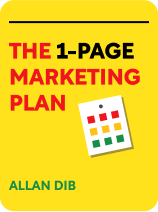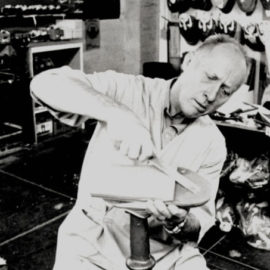

This article is an excerpt from the Shortform book guide to "The 1-Page Marketing Plan" by Allan Dib. Shortform has the world's best summaries and analyses of books you should be reading.
Like this article? Sign up for a free trial here .
Are you looking for an overview of The 1-Page Marketing Plan by Allan Dib? What key ideas can you learn from the book?
Marketing expert Allan Dib contends that for a small business, the surest way to make money and grow is to have a simple, clear marketing plan defining who you’re targeting as prospects and customers and how you’ll reach them.
Find our helpful overview of The 1-Page Marketing Plan below.
The 1-Page Marketing Plan: What You Need to Know
The purpose of a business is to make money and grow—if you don’t make money as a business owner, you’re running a hobby, not a business, according to business coach and entrepreneur Allan Dib.
In The 1-Page Marketing Plan, he shows step-by-step how to create a marketing plan using a simple template that will drive business growth. This guide explains Dib’s method and compares it to other templates and marketing strategies.
Dib argues that many small businesses fail to thrive because they don’t get marketing right. (Shortform note: Similarly, Michael Gerber contends in The E-Myth Revisited that small businesses often fail because they lack business skills such as marketing. Their owners have a technical skill, such as a talent for baking, but don’t know how to make money at it.)
Dib says that most small businesses either 1) neglect marketing entirely, hoping simply to attract customers by word of mouth, or 2) they do the wrong kind of marketing, using big-business strategies that don’t work for small businesses. Dib argues that the answer to small business success is having the right marketing plan, one focused on direct-response advertising designed to prompt the prospect to act. (We’ll discuss direct-response advertising further in the next section.)
(Shortform note: Similarly, a Forbes article lists not having a marketing plan as among the 10 most common small business marketing mistakes. Others include not having a website, prioritizing social media marketing over developing your website, failing to customize your marketing strategy, and ignoring competitors’ marketing strategies.)
Direct-response marketing is a multifaceted topic that you could spend considerable time studying. But our overview of The 1-Page Marketing Plan will help you write and implement a direct-response plan for your business without having to become an expert.
In The 1-Page Marketing Plan, Dib focuses on three customer-focused marketing phases:
- Awareness: In the awareness phase, you’re dealing with prospects. You want to make prospects aware of your product and get them to show interest by responding to a call to action, or an appeal to do something such as download a free report.
- Familiarity: In this phase, you’re dealing with leads, or prospects who’ve moved to Phase 2 by showing interest and taking a step. You want to pursue leads with additional offers and get them to buy from you.
- Enthusiasm: In the third phase, you’re dealing with customers. Your leads have become customers by buying something. In this phase, you want to build enthusiasm so they keep buying from you, become superfans, and recommend your products or services to others.
(Shortform note: Other experts also break marketing planning into three to five phases. But unlike Dib’s template focusing on customers, these plans typically focus on a company’s internal process, which can be more complex. For example, company process steps may include mission, situation analysis, marketing strategy/planning, marketing mix, implementation and control.)
Dib writes that while his plan is intended to simplify and explain marketing, its second purpose is to speed up implementation. But many small business owners fail to implement plans or take action due to analysis paralysis, failure to delegate, or a belief that their business is unique and a particular approach won’t work for them. However, knowing what to do is useless if you don’t do it.
(Shortform note: Analysis paralysis is also referred to as overthinking. Causes include fear of making mistakes and simply having too much information. Some antidotes are trusting your instincts, accepting uncertainty, and making small choices quickly.)
Dib emphasizes that the strategies and tactics underlying his marketing plan are proven, and they work for all types of businesses because they address human behavior, which is common across industries. (Shortform note: Critics of Dib’s book noted that it lacked examples of marketing plans for specific industries. However, on his website, Dib provides five examples of marketing plans created using his template: coach, medical office, e-commerce, software company, and real estate.)
Because marketing grows your business, Dib contends it’s a key business activity you need to do daily if you’re serious about succeeding.
Here’s a deeper look at each of the three marketing phases from The 1-Page Marketing Plan:
Phase 1—Create Awareness
In the first marketing phase, you want people who’ve likely never heard of your business—prospects—to discover you and respond to an offer, thereby becoming leads and entering the second phase. (Shortform note: As noted earlier, each marketing phase entails three steps. To create your own 1-page plan, fill in each step or square on the author’s or your own nine-square template as you read this guide.)
The three steps for reaching prospects are:
- Identify your target market.
- Develop a compelling message for this market.
- Deliver the message through some type of direct advertising.
Phase 2—Build Familiarity
The second marketing phase after creating awareness focuses on developing or nurturing sales leads—people who have indicated interest by responding to your message—and turning these leads into customers.
Dib’s three steps for increasing leads’ familiarity with you so they buy your product are:
- Capture leads in a database.
- Cultivate leads—increase their interest with offers that build in value.
- Convert them into customers (get them to like/trust you enough to buy from you, moving into the third phase of the marketing process).
Phase 3—Build Enthusiasm
The final marketing phase after creating awareness and building familiarity focuses on turning customers who’ve bought from you at least once into enthusiastic superfans who keep buying from you and make referrals.
Dib’s three steps for turning customers into superfans are:
- Give them an extraordinary experience.
- Get them to keep buying more from you, increasing their value to your business.
- Get them to make referrals.
Dib notes that most businesses stop marketing to a customer once she buys something—however, this way of thinking limits business growth. Developing customers into superfans generates ongoing revenue and can help you launch new products because superfans will test the products and evangelize for them.
Exercise From The 1-Page Marketing Plan
The following exercises will help you to apply the lessons from The 1-Page Marketing Plan to your own marketing strategy:
- What business activities do you currently expend the most effort on? What’s your ROI, or the impact versus effort required for these activities?
- Where does marketing fall on your priorities list and why?
- What one or two steps in Dib’s nine-step template would make the biggest difference in your business if implemented and why?
- What activities could you delegate or drop to free up resources for marketing?
The author emphasizes that the key to his simplified marketing plan template isn’t creating your own plan, but implementing it. He faults many small businesses owners for failing to implement.
- What’s a recent business initiative or idea that you considered at length but never implemented?
- Why didn’t you implement it? (The author cites three reasons for failure to implement: analysis paralysis, reluctance to delegate, and believing your business is different. Others are fear of making a mistake and being overwhelmed with information.)
- What would keep you from implementing a marketing plan, and how can you preempt or overcome these obstacles?

———End of Preview———
Like what you just read? Read the rest of the world's best book summary and analysis of Allan Dib's "The 1-Page Marketing Plan" at Shortform .
Here's what you'll find in our full The 1-Page Marketing Plan summary :
- How to create a marketing plan using a simple template
- A guide to the three customer-focused phases of marketing
- How to create enthusiastic superfans—and why they're essential





